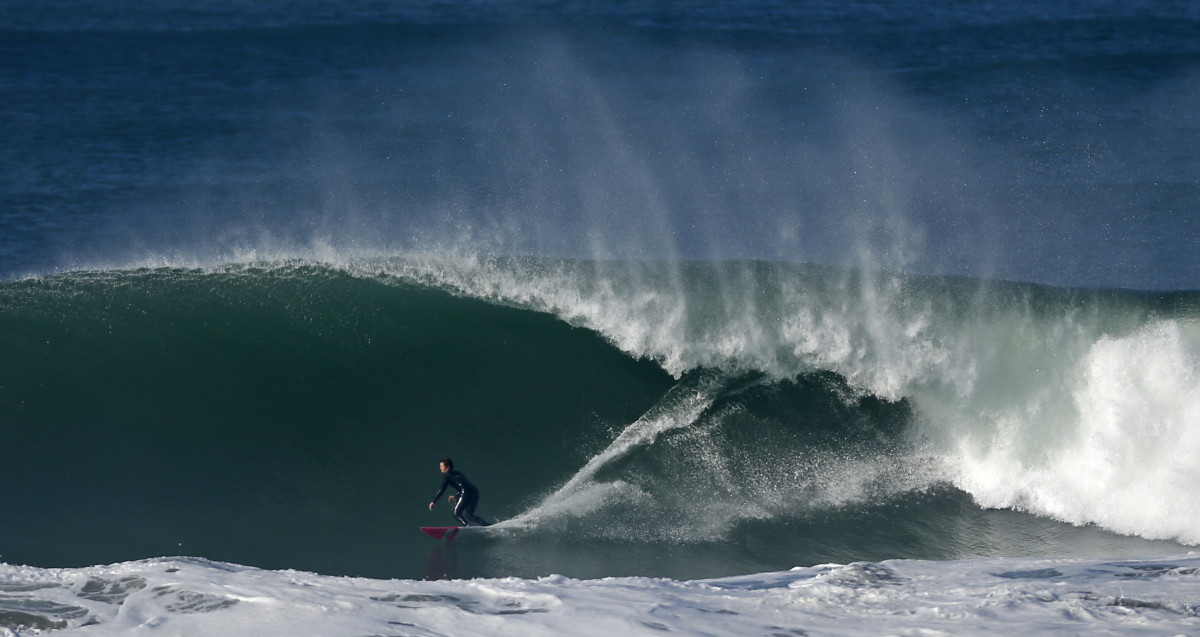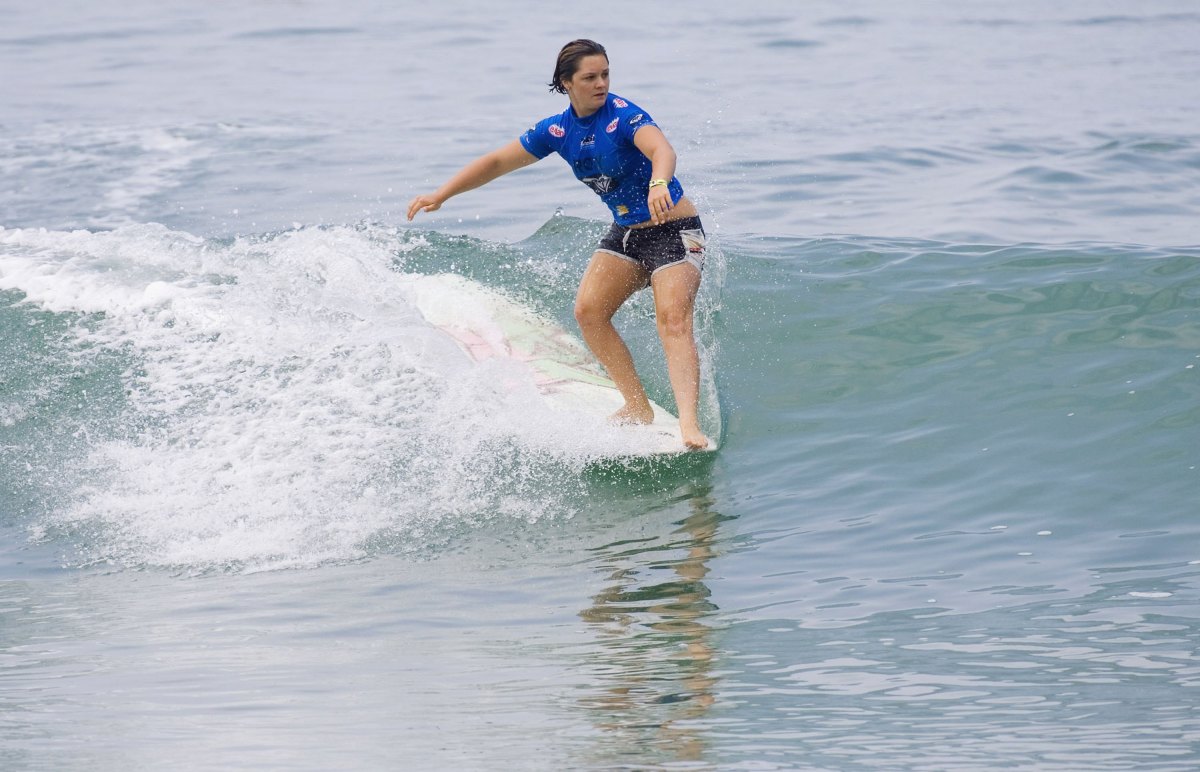International Equal Pay Day, celebrated on September 18, represents the longstanding efforts towards the achievement of equal pay for work of equal value. One young female surfer fought a battle about it. It eventually resulted in the first equal pay achievement in the history of women’s sports. Here’s how Bianca Valenti did it.
Send Out the Girls
No war is ever won with the first battle. Each era finds their priority and picks their fights. The first generation of established professional women stepped up in the 1990s. The previous decade had built a foundation. In the exploding surf market of the go-go 90s “lots of possibilities seemed to be on the table—if you were willing to fight for them,” said 7-time world champion Layne Beachley.
But for women it was often paid for with far more sacrifice. When it came to determining the competition schedule there was always an accepted refrain. It was, as Beachley famously declared, “the waves are shit, send out the girls.”
One woman in the U.S. was determined to challenge that longstanding assumption. She was a five foot five, 112-pound coiled spring with a pink surfboard, an adopted pet Chichi dog from a Mexico trip, and the guts to elbow her way into 50-foot waves with the best of them. Bianca Valenti – an Ocean Beach transplant from Southern California – was about to test the power of a woman’s courage – and try to hurdle a barrier that had stood for decades.
Related: The 2024 SURFER Big Wave Challenge Nominees Are Here
Hooked On a Feeling
Valenti started surfing on a longboard as a kid in Orange County. But once she visited the Bay Area’s big-wave epicenter she quickly realized that riding giants was her true passion. Valenti’s first taste of big waves came unexpectedly when she paddled out at Ocean Beach, the stretch of San Francisco’s shoreline that attracts open ocean swells.
“It was a beating like no other,” she recalled. “My board was instantly ripped out of my hands. I was spinning in every direction imaginable, had no idea which way was up, and when I opened my eyes, I saw only blackness. I thought, if there’s another wave after this one, I’m dead.”
She got back to shore and stood there, “watching these amazing, giant, perfect waves, thinking to myself, ‘I want to ride those waves. I can do this. I have to start preparing.’”
In 2014, Valenti and the seven other best female big-wave surfers were invited to Nelscott Reef in Oregon, one of six stops on the then-men’s-only WSL Big Wave World Tour. She won the event while still healing from a torn medial collateral. With that astonishing victory she became the first-ever champion of a women’s big-wave competition.

Scott Strazzante / San Francisco Chronicle / Getty
High On Believing
Within weeks she had moved to San Francisco, finding a pastel, salmon-colored flat in the Outer Sunset neighborhood about five blocks from the Great Highway, where frequent banks of Bay Area fog muffle the faint jangle of distant street cars.
“All I wanted to do I’ve been dreaming since I was seven years old—I have it written down in a third-grade essay—that I wanted to be a Pipeline Master [the winner of the renowned Hawaiian surfing contest],” she confessed. “And all my life I’ve never had the opportunity because they’ve never had women.”
“Bianca is a one-of-a-kinder,” Keala Kennelly told me. “She’s funny, smart, bold—and so damned positive all the time. At first you almost can’t believe she’s for real,” Kennelly laughed. “But after you know her, that’s just the way she is. All the time.”
In 2014, Valenti and the seven other best female big-wave surfers were invited to Nelscott Reef in Oregon, one of six stops on the then-men’s-only WSL Big Wave World Tour. She won the event while still healing from a torn medial collateral. With that astonishing victory she became the first-ever champion of a women’s big-wave competition.
Afterward, as writer Claire Greenburger noted last winter “Valenti was fired up, ready to campaign for women’s rights to participate in all six of the tour’s stops.”

Karen Wilson / WSL / Getty
A Rare Person
“Bianca is the rare person whose soaring ambition was matched by her formidable talents,” concluded Sachi Cunningham, who spent many hours in dangerous situations with Bianca. Her peers agreed.
“Bianca spearheaded the effort to get equal access and equal prize money,” Layne Beachley pointed out. “The great thing is she is so positive about her approach.”
Armed with a quiver of eight-foot-plus guns, Valenti built a solid level of performance skills while working as a sommelier at her dad’s Italian restaurant, Valenti & Co., in Mill Valley.
A Super-skilled Big-wave Barrel Rider, “Bianca is a super-skilled big-wave barrel rider,” stated Beachley without reservation.
“She was definitely the best woman at [Mexican big-wave beach break] Puerto Escondido.”
“It takes a tremendous amount of hard work to be out there—for anyone. But if you’re a woman, you have exponentially more work, mentally and physically,” Valenti explained. “To catch waves, you have to be able to match the speed of the wave and most men have an easier time with this, with more muscle mass up top and a longer wingspan. For every man’s paddle-stroke, I have to do three.”
Related: From Down the Beach: Bianca Valenti Wins Puerto Escondido Waiting Game
It was a series of battles. Step by step, Valenti earned a place in the Mavericks lineup, where she continually surfed bigger and bigger waves. But there was a barrier she still couldn’t quite bust through: women’s ability to compete and their right to equal pay. It still remains – after 10 surf competitions at the fabled spot – not one has included women.
So Valenti’s next fight – as could be expected – was Mavericks. As a regular, it seemed perfectly logical that she should be able to compete at her home break. “ I had no idea the fight that we were about to get into,” she told me.
A Historic Milestone
In 2016, Valenti cofounded the Committee for Equity in Women’s Surfing to
create opportunities for women to surf in big-wave contests. Valenti and her crew of other female big-waves surfers—among them Paige Alms, Andrea Moller, and Keala Kennelly outlined their demands for Mavericks: that at least half of the surfers be women, and that men and women should earn equal cash prizes. Any beach event needs approval from the California Coastal Commission, a state agency, barring women could be a form of gender discrimination, something explicitly banned by the California Coastal Act of 1976.
In November 2016, the Coastal Commission of California required the organizers of the Mavericks Challenge—a high-profile U.S. surfing contest—to open the event up to women in order to approve their permit.
“I think what it boils down to is the question of how public resources are used,” Valenti explained, “and it’s important for everybody to have accessibility to public resources.” For Valenti, competition access was the primary barrier to women in the sport. After deliberations on Valenti’s case six women were invited to the competition for the first time. It was a milestone in women’s sports and made headlines across the nation.
Related: Top 5 Moments in the Fight for Pay Equality in Surfing According to Sachi Cunningham
A Win is Not the End
But winning a battle and winning a war are very different things as we know. In a Seirra Club article in March of this year, author Claire Greenburger noted “Surf conditions didn’t cooperate that year, however, and the contest never happened. It has now been five years since Valenti won women’s right to compete at Mavericks, and the competition still hasn’t happened, mostly due to a lack of funding. Nevertheless, at 38 years old, Valenti is still charging, surfing the world’s heaviest waves, including in competition. And most recently, in December 2019, women competed alongside men at Jaws, an iconic break on the north shore of Maui, where they earned equal cash prizes.”
Will the competition Valenti fought so hard for happen in her surfing lifetime? “I’m hopeful that Mavericks will happen for the next generation,” she says. “That’s really what gets me inspired these days.”
A Rare Combination
Valenti was a rare combination of sass, strength and social savvy.
“As a woman, you have to constantly prove yourself, whereas a guy—even of lesser experience—will paddle out and no one will say anything. Now I get cheered on [by the guys], but it took me a while. Psychologically, it was the hardest thing to deal with that hungry pack of wolves while I earned my place.”
Self-confidence and determination were tempered with political intelligence and a sensitivity to the disparate parties involved to negotiate well without accruing acrimony in the process.
For the Love
Mavericks maestro Grant Washburn found Valenti a kindred spirit. A lesser known big wave star, he too moved to San Francisco in 1990 for the same reason Valenti had: to surf big Ocean Beach.
“You know she’s in it for the love, because nobody really sees what you’re doing out there,” he said. “I remember one day she told me she was ready to try Mavericks—and she’s done that over the years. I’ve seen her out at solid, serious Mavericks without any cameras around and just a few people out, having the best time. For the love.”
For those who take on the out-of-scale monsters that lunge from the deep ocean storm zones, who surf for little recognition, even less money, there is really no other explanation. All valenti wants a is a little piece of the equity.
“I’m a female and I’m a surfer, therefore surfing is feminine,” said Valenti. “Men
feel like we’re trying to take something away from them, but we’re not. We’re all in this together. Let’s celebrate men and women.”
Related: Keala Kennelly and the Fight for an Equal Spot in the Lineup

